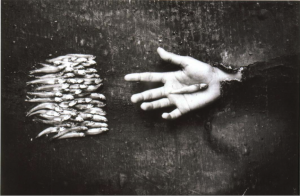In precedenza: (1) Quando la mano si fa voce (2) La carezza è risveglio dei sensi – (3) Non sempre le parole riescono a raggiungerci – (4) Per il bambino la carezza è formazione – (5) Il nostro Io pensante emerge attraverso la pelle – (6) La carezza ci conduce all’idea dell’infinito. A seguire: (8) La carezza è memoria impressa nel tempo – (9) La carezza è naturalezza che scorre fluida – (10) La metafora della carezza costruisce la pace – (11) Senza carezze viene meno la speranza – (12) La carezza lotta contro l’indifferenza.
La carezza, con il suo movimento immobile, diventa uno spazio aperto alle verità e alle singolarità dell’altro, una mano vuota che non agisce e che non trattiene nulla ma che si riempie dell’ascolto dell’altro, una sorta di anti-mano, secondo una felice espressione di Jean Brun. “Spesso la nostra vita è solamente lo sforzo che facciamo per raggiungere l’altro; la carezza incarna questo sforzo, tutti i tormenti che nascono dalla nostra impotenza. La mano diventa l’antitesi della mano potente e risolutiva, una anti-mano che cerca di avere accesso all’intangibile, che per sua essenza, sfugge all’idea stessa di contatto. Così è la mano che si posa sulla fronte di colui che, divorato dalla disperazione, non appartiene più a se stesso; tenta, con la dolcezza stessa del suo contatto, di riportare alla normalità non solamente i ritmi vitali, ma l’esistenza stessa di ciò che sembra impossibile. La carezza che calma si sposterà poi a un mondo possibile divenendo la presenza che rimane, la porta, l’àncora per la nave”.
Nei versi delle Elegie Duinesi (“Lo so, vi toccate beati così, perché la carezza trattiene, perché non svanisce quel punto che, teneri, coprite; perché in quel tocco avvertite il permanere puro. E l’abbraccio è per voi una promessa quasi di eternità”) Rainer Maria Rilke si ricollega a quanto da lui scritto in precedenza in un saggio sulle mani di Rodin: laddove due corpi si toccano ne nasce un altro, un terzo corpo intangibile che va oltre il me e il te e li accoglie.
Mentre nelle carezze dell’amore fisico la mano cerca costantemente un nuovo altrove, nella carezza d’amore non finalizzata all’unione fisica la mano si pone tra gli individui quasi come un impedimento per non farli dominare singolarmente ma farli convergere in un terzo spazio, quello di un’amicizia profonda, di un affetto sociale o di un amore spirituale.
CARESS IT’S NOT JUST A WORD
(7) The caress is a mental aperture towards the uniqueness of the other
Before: (1) When the hand becomes word – (2) The caress is an awakening of the senses – (3) Words cannot always reach us – (4) For the child a caress is development – (5) Our thinking Ego emerges through the skin – (6) The caress leads us to the concept of the infinite. To follow: (8) The caress is memory imprinted in time – (9) A caress is spontaneity unrestrained – (10) Caress as metaphor builds peace – (11) Hope dies without caresses – (12) The caress fights indifference
The caress, with its motionless movement, becomes a receptive space for the truths and singularities of the other, an empty hand that is doing nothing and that is retaining nothing but that is being filled by its listening of the other, a sort of anti-hand, to use Jean Brun’s well-put expression. “Often our life is nothing but the endeavor we make to reach the other; the caress incarnates this endeavor, all the torments that arise from our impotence. The hand becomes the antithesis of the powerful and resolutive hand, an anti-hand seeking access to the intangible, which by definition is something that is untouchable. Thus the hand placed on the brow of the person, consumed by desperation, no longer his own master, attempts, with the sweetness of its touch, to bring back to normality not only the vital rhythms, but the very existence of what seems impossible. The calming caress then moves on to a possible world and becomes the presence that remains, the door, the anchor for the ship”.
In the Duino Elegies “(…) I know/ you touch so blissfully because the caress withholds, / because the place you cover so tenderly/ does not disappear: because beneath it you feel/ pure duration. So that you promise eternity/ almost, from the embrace.” Rilke re-connects with what he had previously written in an essay on Rodin’s hands: where two bodies touch, another, a third intangible body, is created, that goes beyond the me and the you and embraces them. While in the caress of physical love the hand constantly seeks for a new elsewhere, in the caress of love not meant for physical union the hand places itself between the individuals as if to impede domination of the one or the other, bringing them together in a third space, that of a profound friendship, a social affect or a spiritual love.

